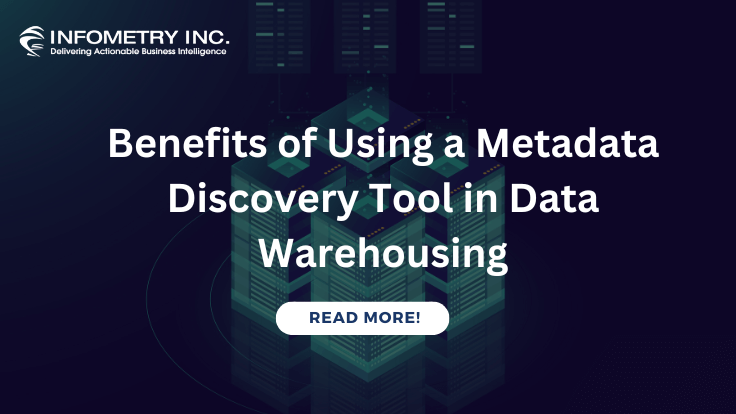
Empowering Businesses with Informatica Intelligent Data Management Cloud
February 29, 2024
Strategic Data Architecture for Unparalleled Data Quality
March 4, 2024In today’s data-driven era, businesses are inundated with vast amounts of information from various sources. To extract valuable insights and make informed decisions, organizations turn to data warehousing solutions. One such player making waves in the field is Infometry. In this blog post, we will delve into the main purpose of a data warehouse and explore how Infometry is contributing to this crucial aspect of modern business intelligence.
Defining Data Warehouse:
A Data Warehouse is a centralized repository that accumulates and integrates large volumes of data from various sources within an organization. Unlike traditional databases, which are designed for transactional processing, a Data Warehouse is specifically optimized for analytical processing and reporting. The primary objective is to provide a unified, historical view of an organization’s data to support decision-making processes.
Key Components of a Data Warehouse:
Data Sources:
Data Warehouses ingest data from diverse sources, including operational databases, external systems, flat files, and more.
The data can be structured, semi-structured, or unstructured, encompassing a wide range of formats.
ETL (Extract, Transform, Load) Processes:
ETL processes are crucial in Data Warehousing. They involve extracting data from source systems, transforming it into a consistent format, and loading it into the Data Warehouse.
Transformation may include cleaning, aggregating, and enriching data to ensure consistency and quality.
Data Storage:
Data Warehouses store data in a structured manner, typically using a relational database management system (RDBMS). Tables are organized to facilitate efficient querying and reporting.
Star or snowflake schema designs are common, enabling easy navigation and retrieval of information.
Metadata:
Metadata, or data about data, is integral to a Data Warehouse. It includes information about data sources, data transformations, and the structure of the warehouse.
Metadata helps users understand the meaning and context of the stored data.
Query and Reporting Tools:
To extract insights from the stored data, Data Warehouses are equipped with powerful query and reporting tools. These tools allow users to create and execute complex queries, generate reports, and visualize data.
Benefits of Data Warehousing:
Centralized Data Repository:
A Data Warehouse provides a centralized and consolidated view of an organization’s data, eliminating data silos and promoting a holistic understanding.
Historical Analysis:
By storing historical data, Data Warehouses enable organizations to analyze trends, track performance over time, and make informed decisions based on historical insights.
Improved Decision-Making:
With the ability to analyze and interpret data efficiently, decision-makers can make informed, data-driven decisions, leading to better business outcomes.
Enhanced Performance:
Data Warehouses are optimized for analytical processing, providing faster query performance compared to transactional databases.
Challenges and Considerations:
Data Quality:
Ensuring the quality and accuracy of the data being loaded into the Data Warehouse is crucial. Inaccurate or inconsistent data can lead to erroneous insights.
Scalability:
As data volumes grow, scaling a Data Warehouse to handle increasing loads becomes a significant consideration. This may involve hardware upgrades or adopting cloud-based solutions.
Security and Compliance:
Safeguarding sensitive data and ensuring compliance with data protection regulations are paramount in Data Warehousing.
Understanding the Main Purpose of a Data Warehouse:
A data warehouse is a centralized repository that allows organizations to store, manage, and analyze large volumes of structured and unstructured data from diverse sources. The primary purpose of a data warehouse is to facilitate efficient reporting, analytics, and decision-making processes. Let’s break down the key objectives that define the main purpose of a data warehouse:
Data Integration:
A data warehouse consolidates data from various sources, such as operational databases, spreadsheets, and external systems, into a unified and standardized format.
Infometry specializes in data integration solutions, offering seamless connectivity and transformation capabilities to ensure data consistency and accuracy.
Historical Data Storage:
Unlike operational databases that focus on current data, a data warehouse stores historical information, enabling organizations to analyze trends, patterns, and changes over time.
Infometry’s data warehousing solutions emphasize the importance of historical data preservation for comprehensive business analysis.
Query and Analysis:
Data warehouses provide a robust platform for complex queries and data analysis, allowing users to derive meaningful insights from large datasets.
Infometry’s tools offer advanced querying capabilities, empowering users to explore and visualize data in a user-friendly manner.
Performance Optimization:
To ensure swift query response times, data warehouses are optimized for analytical processing, often utilizing techniques like indexing and partitioning.
Infometry incorporates performance optimization features, ensuring that users experience smooth and efficient interactions with the data warehouse.
Business Intelligence and Reporting:
Data warehouses serve as the foundation for business intelligence (BI) and reporting tools, enabling organizations to generate actionable insights and reports.
Infometry’s BI integration capabilities enhance the overall effectiveness of data-driven decision-making processes.
Infometry’s Contribution to Data Warehousing:
Infometry emerges as a key player in the data warehousing landscape, offering innovative solutions that align with the evolving needs of businesses. With a focus on data integration, performance optimization, and user-friendly interfaces, Infometry ensures that organizations can harness the full potential of their data warehouses.
Conclusion:
In conclusion, a Data Warehouse serves as the backbone of modern analytics, providing organizations with a powerful tool to harness the potential of their data. By centralizing, organizing, and optimizing data for analytical processing, businesses can gain valuable insights that drive informed decision-making. The main purpose of a data warehouse is to provide a robust and centralized platform for organizations to store, integrate, and analyze their data effectively. Infometry’s contributions to the field, particularly in data integration and performance optimization, highlight its significance in empowering businesses to make informed decisions based on comprehensive insights. As the landscape of data continues to evolve, Infometry stands as a reliable ally for organizations seeking to unlock the true potential of their data warehouses.




